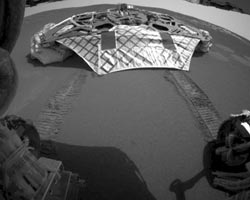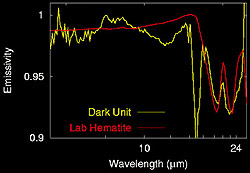
Opportunity's rear hazard-identification camera imaged the lander shortly after the rover rolled onto Martian soil on January 31, 2004. The rover is about 1 meter in front of the lander.
Courtesy NASA/JPL.
A briefing held at NASA's Jet Propulsion Laboratory this morning offered a double dose of good news. The Mars rover Opportunity has found what it was sent to look for: a mineral called hematite that often forms in liquid water on Earth. Engineers also reported the rover's successful rollout onto the red planet's surface.
The "fingerprint" of hematite shows up clearly in a spectrum taken by Opportunity’s Miniature Thermal Emission Spectrometer (Mini-TES). "We found hematite; we’re in the right place," said Mini-TES lead scientist Phil Christensen (Arizona State University).
The hematite signature appeared when Mini-TES was aimed toward dark, loose grains that lie on top of the underlying bedrock. The hematite appears to be mixed together with another as-yet-unidentified material. The dark grains probably originate in a rock layer that lies on top of the bedrock, and over the next few days scientists will direct Opportunity to look for that rock layer. The hematite signature does not appear in the bedrock itself.

Opportunity’s Miniature Thermal Emission Spectrometer acquired this infrared spectrum of nearby Martian soil. The yellow line representd the spectrum of the Martian soil; the red line shows the spectrum of pure hematite. The two deep depressions at the right, which form a W-shaped pattern, indicate the presence of hematite, a mineral that on Earth often forms in the presence of water.
Courtesy NASA/JPL and Arizona State University
Scientists knew that this region of Mars, called Meridiani Planum, was blanketed with hematite from orbital data taken by Mars Global Surveyor’s TES instrument. But having a rover on the surface will allow for the detailed, close-up tests that should reveal how the hematite formed and how it relates to the possible existence of liquid water in Mars’s distant past.
On Earth, hematite often forms in wet environments, such as in lakes and hot springs, but it can also form by volcanic processes. "At the moment, the spectrum matches best something that started in a low-temperature environment," said Christensen. This result tentatively supports a water origin. Over the next few weeks, Opportunity will analyze the material at close range with its Microscopic Imager and spectrometers to look for textures and precursor minerals that will resolve how the hematite formed.
Opportunity rolled down an exit ramp and touched the surface of Mars early Saturday morning, January 31st. The rover is currently about one meter from the lander. "She is now where’s she is supposed to be, on the plains of Meridiani," said mission manager Matt Wallace (NASA/Jet Propulsion Laboratory).
NASA’s other rover, Spirit, spent 12 sols (Martian days) on its lander before heading down the ramp. Opportunity was able to touch Martian soil in less than 7 sols because almost all of its systems were performing as well or better than expected, and because the flight team had the experience of Spirit behind it. Opportunity will spend the next several days investigating the soil in its immediate vicinity. Then it will head to an outcrop of layered bedrock about 8 meters away.
 0
0
Comments
You must be logged in to post a comment.